Kuru Fasulye is a traditional Turkish bean stew. It's a popular, easy-to-make dish that's both healthy and delicious. A super satisfying dinner for chilly days.
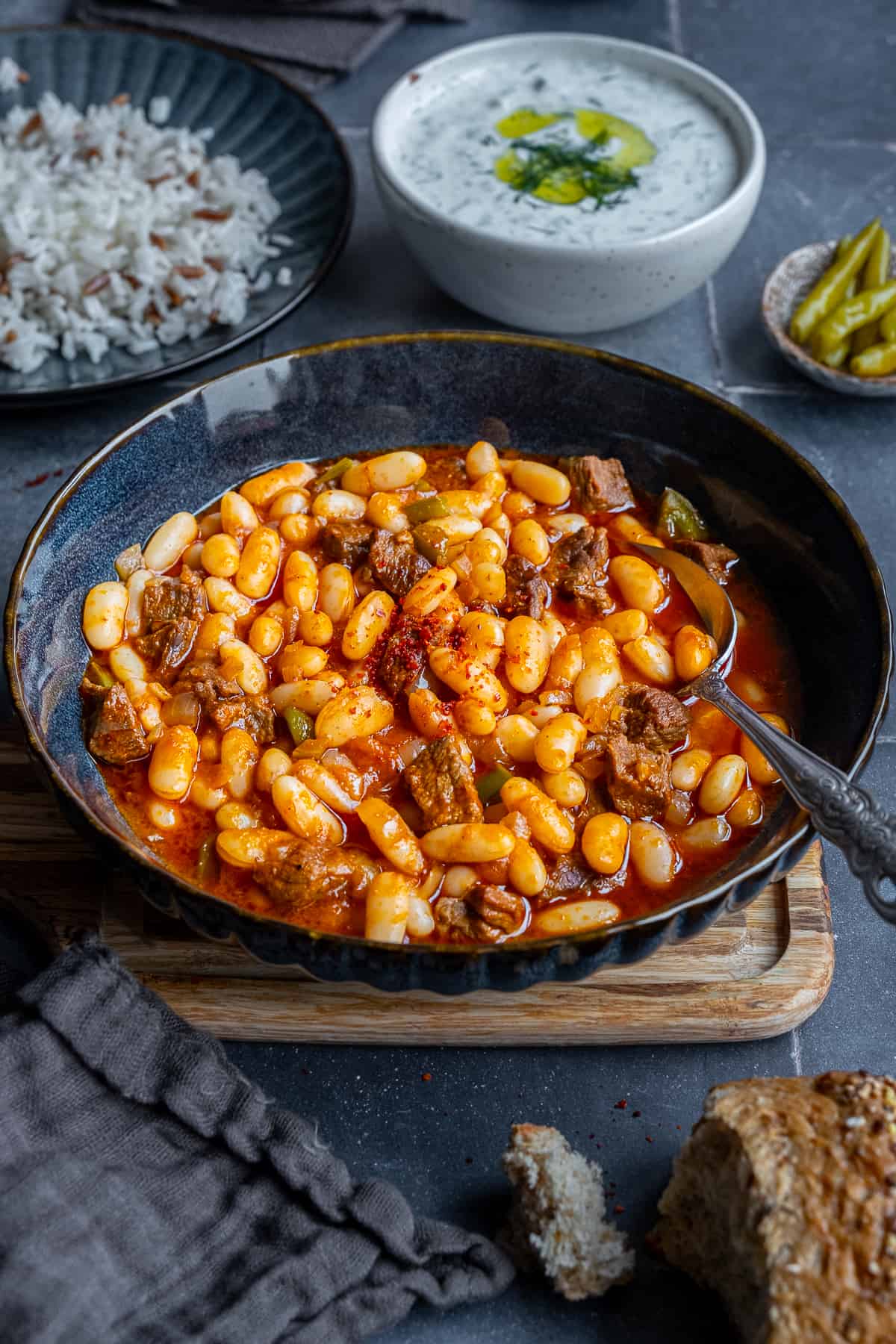
This white bean stew is one of the top traditional Turkish dishes that is loved all around the country. We make Kuru Fasulye Pilav (bean stew paired with pilav) for dinner often, particularly during the cold months.
This Turkish white bean recipe stands out among other Turkish recipes for its ease of preparation and great taste. With little effort, it offers a warm, hearty meal that's perfect for cozy evenings.
You will love this recipe because:
- Flavorful and comforting: The combination of tender white beans and rich tomato sauce pleases everyone.
- Nutritious: White Beans are packed with protein, fiber, and essential nutrients.
- Versatile: This dish can be made meaty or vegetarian. Both versions are super tasty!
- Easy to prepare: It is a simple recipe with straightforward steps.
- Freezer-friendly: It can be prepared in advance and stored in the freezer.
Jump to:
- What is Kuru Fasülye In Turkish Culture?
- Want More Turkish Stews?
- Ingredients
- Why Soaking Beans Overnight?
- Can I Use Canned Beans?
- How to Make It
- Our Tips
- Can I Cook The Beans In A Pressure Cooker?
- Variations
- What to Serve with Kuru Fasulye
- Storing & Reheating
- FAQs
- Other Bean Recipes
- More Hearty Turkish Recipes
- You Might Also Like:
- 📖 Recipe
What is Kuru Fasülye In Turkish Culture?
The Meaning Behind the Name
"Kuru" means "dry" and "Fasülye" means "beans". So, "Kuru Fasulye" means "dry beans". But the same phrase is also used for the dish itself.
Turkish white bean stew is called kuru fasulye, which is known as the national dish of Turkey. Everyone, including kids, enjoys it heartily.
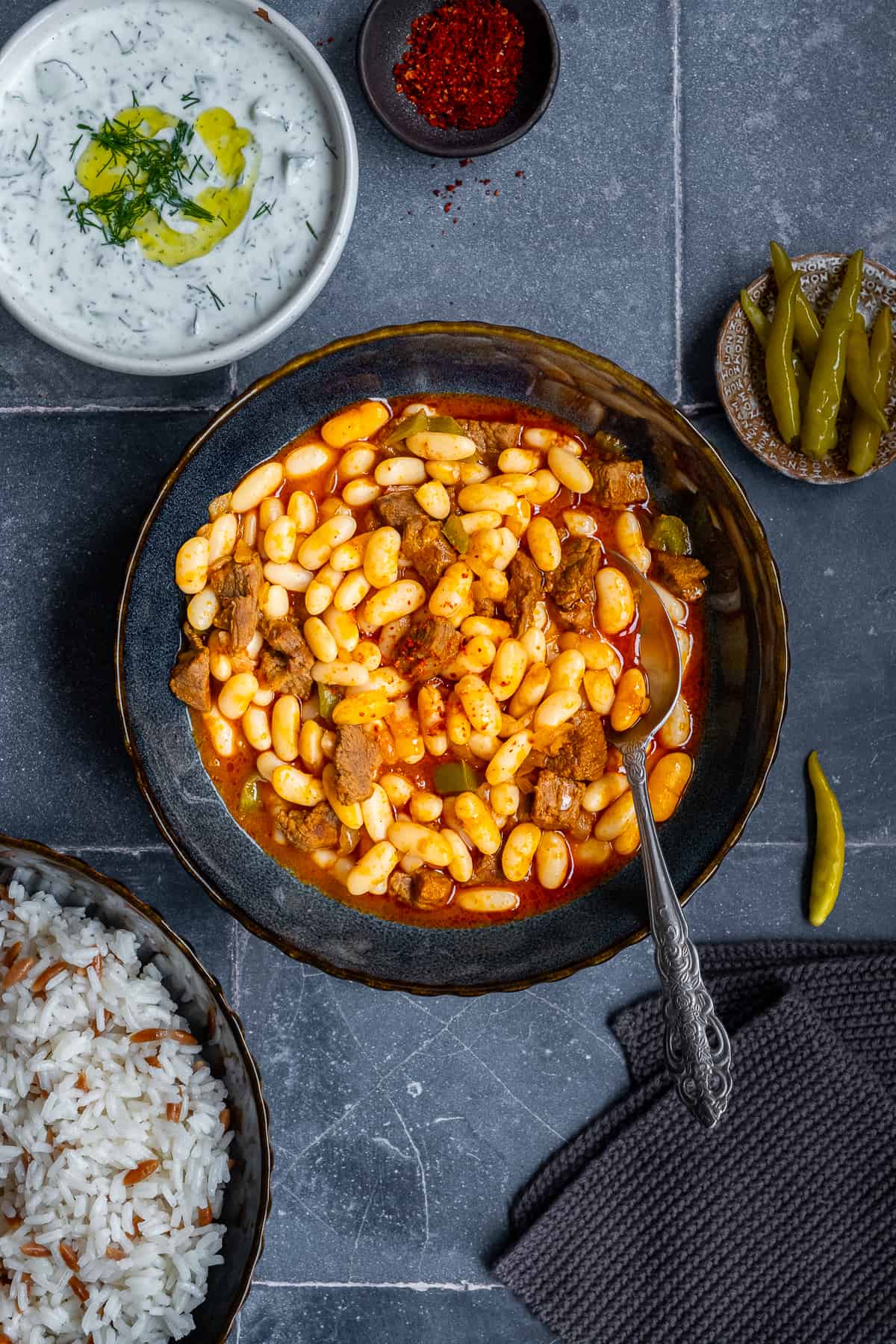
Lokanta Menu Staple
This flavor-packed white bean stew with beef (etli kuru fasulye) is a staple in Turkish lokantas (local eateries in Turkey serving only traditional soups, stews and desserts).
You can see a lot of lokantas in Istanbul. They are the best lunch places where you feel in the heaven of homemade dishes from Turkish cuisine!
In a typical lokanta, Turkish beans stew is often paired with Turkish pilav, making it a complete and satisfying meal.
The style of serving has a name itself: Pilav üstü kuru, meaning pilav topped with white bean stew. You can order pilav üstü kuru as a meal on its own or as a side dish to pair with a main dish.
Want More Turkish Stews?
If you are a fan of comforting stews like etli kuru fasulye, we have several of them on the blog. Here are a few of our favorite Turkish meat dishes:
- Turkish Beef Stew
- Lamb Guvec (Lamb Stew)
- Turkish Meatball Stew (Meatballs with peas) - Our son's favorite!
- Kapuska (Cabbage Stew)
Ingredients
So what do we need to make this easy Turkish white bean recipe? Here is a list:
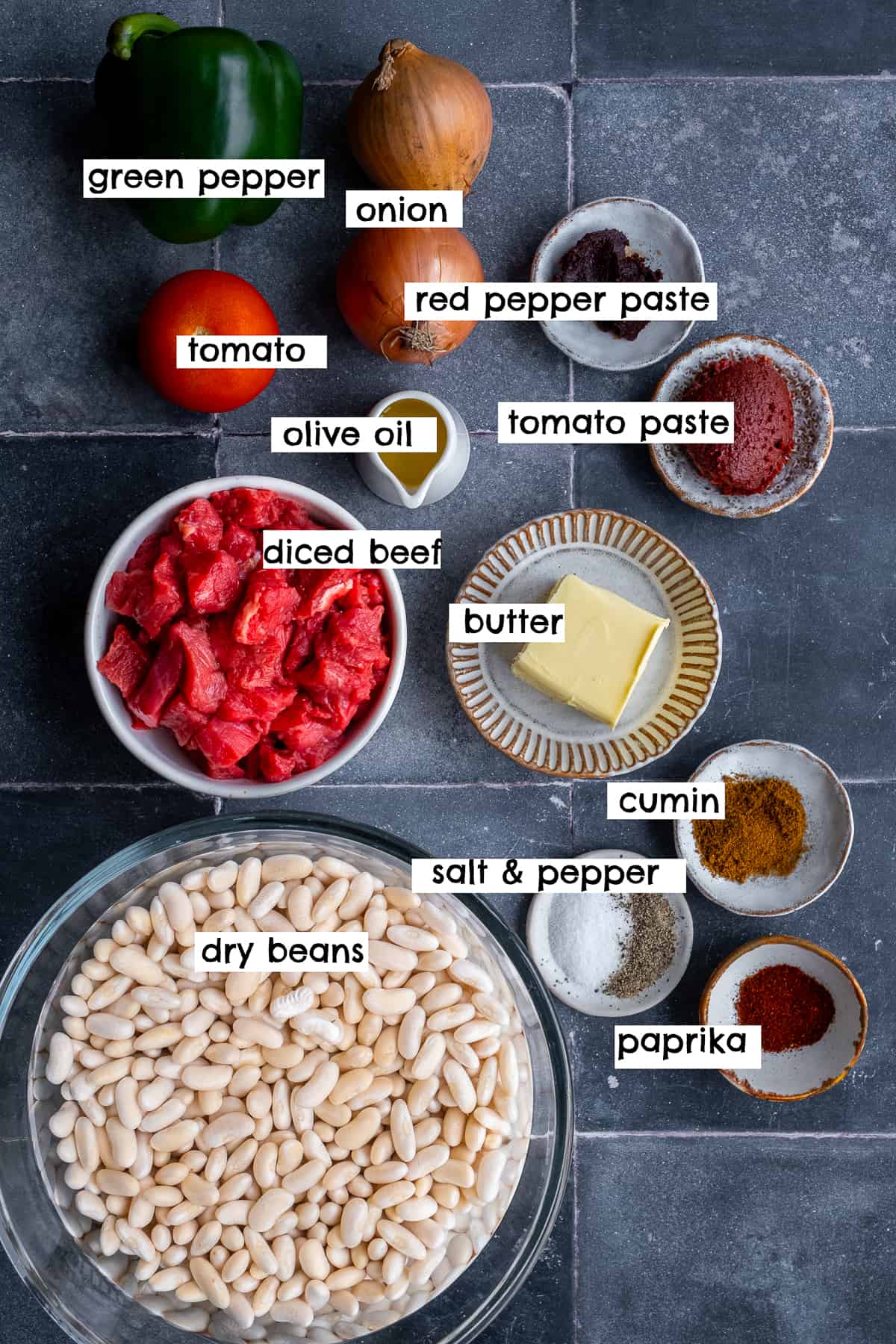
- Dried white beans: In Turkey, Dermason beans or Ispir beans are commonly used for their unique texture and flavor absorption capabilities. Are you not in Turkey? Use cannellini beans or navy beans.
- Olive oil: Just 1 tablespoon to cook the meat.
- Beef or lamb: These meats make the dish more filling and add a rich flavor. You can leave them out for a vegetarian version.
- Butter: It gives an amazing richness and flavor. We use 57 grams (2 ounces or 4 tablespoons). You can decrease or increase the amount depending on how much you like the flavor of butter.
- Onion: Diced onion adds sweetness and flavor to the dish.
- Spices: Cumin, black pepper and paprika give kuru fasulye its warm, deep flavor.
- Green bell pepper: We use it as a substitute for Turkish green peppers. You can use a mixture of red and green peppers if you want.
- Tomato: Diced tomato adds freshness and a bit of acidity to balance the flavors. You can use canned tomatoes if fresh ones aren't available.
- Tomato paste (domates salcasi) and red pepper paste (biber salcasi): These pastes give the bean beef stew a deep color. If you can't find red pepper paste, use an extra tablespoon of tomato paste.
Why Soaking Beans Overnight?
Soaking is the Key
Soaking beans overnight is a crucial step in making an authentic kuru fasulye recipe.
This process softens the beans, making them cook evenly and become tender. When beans are soaked, they absorb water.
This means they'll cook faster and more thoroughly. Without soaking, beans can be hard and take a long time to cook.
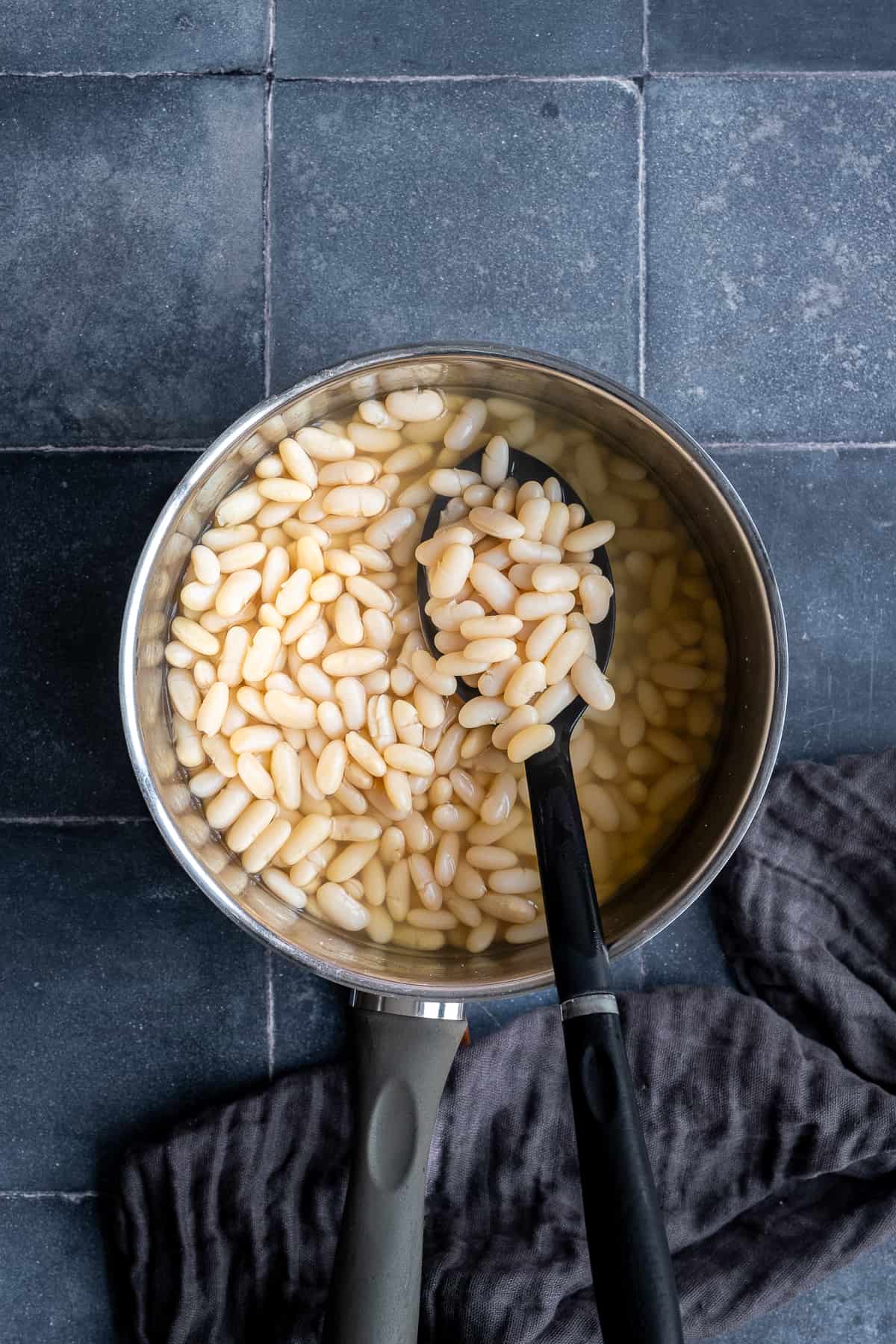
Better Flavor and Consistency with Soaked Beans
We soak beans overnight, drain and cook them in fresh water. As the beans cook, they release starch into the water.
This water in which the beans are cooked is used in the stew. It makes the stew more flavorful and with a nice consistency thanks to the starch of the beans.
You can get this result in your Turkish bean stew only if you soak dry beans overnight.
Keeping the Right Texture
Soaked beans keep their shape in the stew. Their skins stay on, and they get soft but not too mushy. This makes the stewed beans feel just right.
Can I Use Canned Beans?
Yes, you can use canned beans for Kuru Fasulye. But there are some things to keep in mind.
Canned beans are already cooked and most of them are too soft. When you add them to the stew, they can get mushy faster. This changes the texture of the stew.
Also, canned beans have less flavor than dried beans that you soak and cook yourself. The soaking and cooking process adds a lot of taste to the beans and the stew. With canned beans, you miss out on this extra flavor.
If you're in a hurry or don't have dried beans, canned beans can be a quick option. Just remember, the stew might not have the same taste and texture as with soaked dried beans. It's still good, but a bit different.
Quick tip: For the best Kuru Fasulye, remember to soak your beans the night before. It's easy and makes a big difference.
How to Make It
With just a few simple steps and ingredients, you'll be able to create this delicious and comforting Turkish dish in no time.
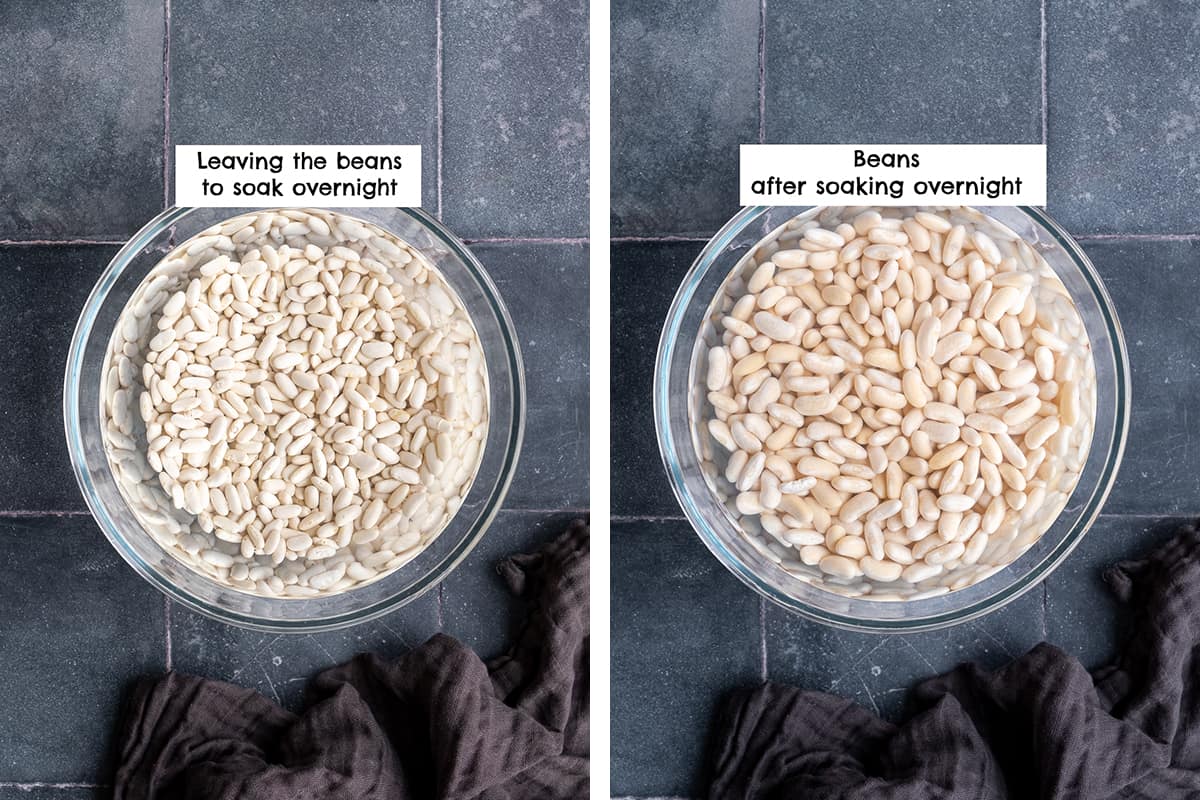
Soak the Beans
- Rinse the white beans well.
- Place them in a large bowl.
- Fill it with plenty of water (we use 8 cups of water for 2 cups of dried beans) and let the beans soak overnight or at least for 8 hours. This helps them cook easier.
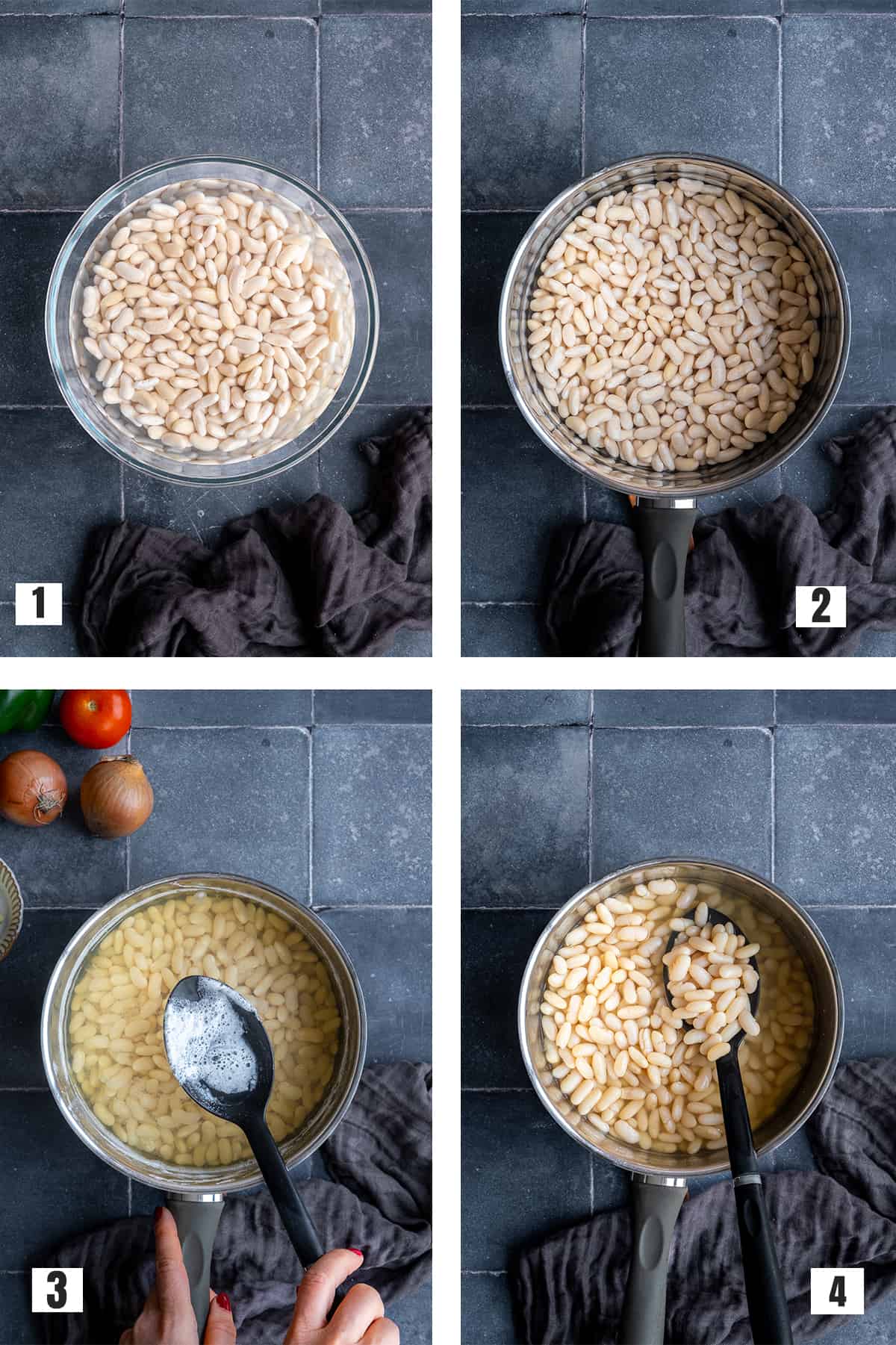
Cook the Beans
- Drain the beans and set them aside. Discard the soaking water.
- Put them in a large pot. Pour 4 cups of water (at room temperature) over the beans and bring to a boil uncovered.
- Once it starts to boil, reduce the heat to medium low and let it simmer partially covered until tender. Remove the foams on the surface once or twice while the beans are cooking.
- It takes 35-40 minutes, but check it after 30 minutes as the duration might be different depending on the type of the beans you are using.
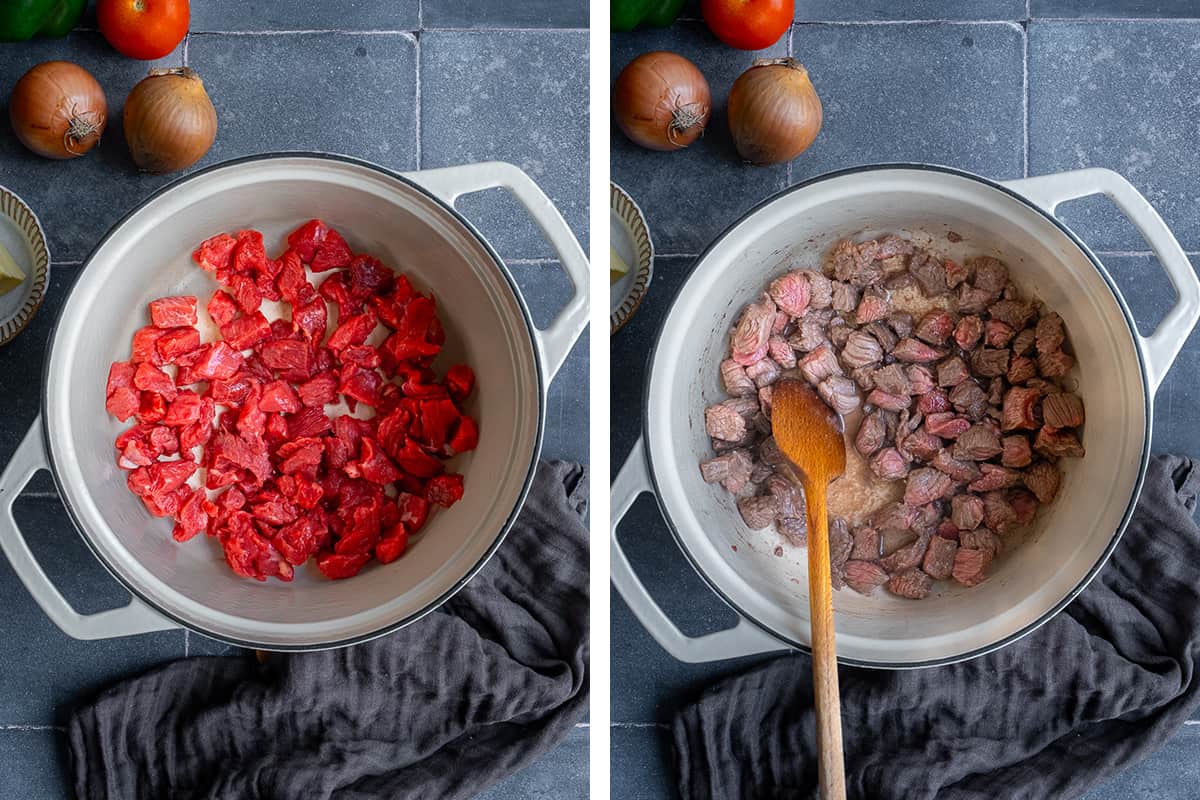
Cook the Meat
- While the beans are cooking, heat olive oil in a large saucepan over medium heat. We use a Dutch oven, but an earthen cookware (as we say güveç in Turkish) or a normal pot works fine too.
- Add the diced beef and cook it over medium high heat for 5 minutes or until it releases its juice.
- Give it a good stir, reduce the heat and let it cook covered over medium low heat for about 20 minutes. Check it to make sure there is enough juice. If there is no juice left, pour about ¼ cup water and keep cooking it covered for another 20-25 minutes or until tender. Check it a few times to make sure there is enough water in the pot. If it gets too dry, add a little water and keep cooking.
Pro tip: If you are using lamb meat, it will cook much faster. Probably it takes about 30 minutes.
Assemble the Stew
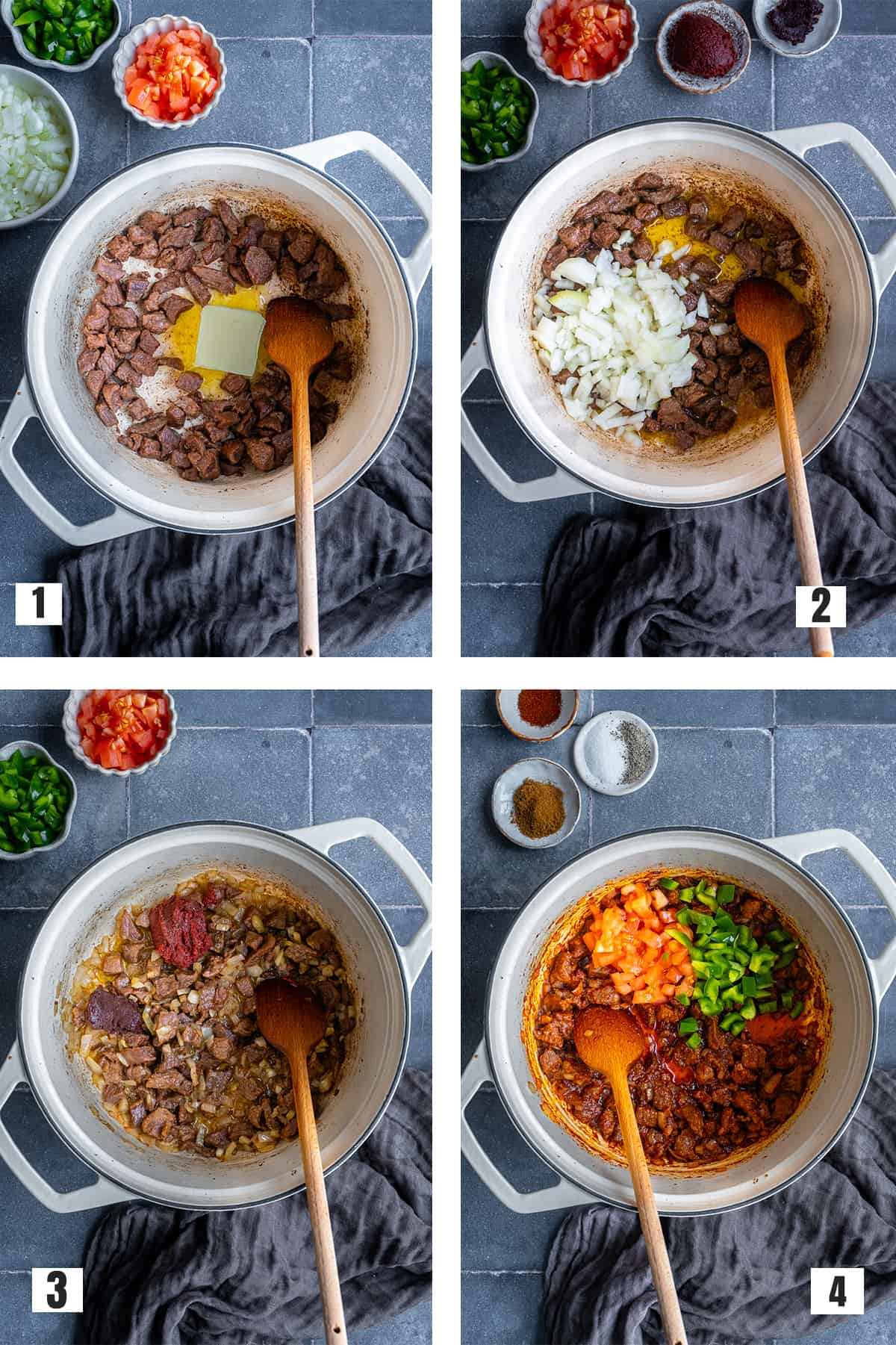
- When the meat is tender enough, add butter in the pot, stir and let it melt.
- Add in diced onion and cook it covered over medium low heat until soft. Stir it a few times while it is cooking.
- Add in tomato paste and red pepper paste. Cook together for 2-3 minutes, stirring constantly.
- Add in diced pepper and tomato. Give it a good stir and cook them covered over medium low heat for 3 minutes.

- Pour ½ cup of water into the pot and stir well.
- Add the cooked beans with all the water they are cooked in and all the spices.
- Give it a stir and cook everything together covered over medium high heat until it boils. Once it boils, reduce the heat to medium low and let it simmer for 10 minutes.
- Let it rest for 15 minutes and serve.
Our Tips
- Soak Beans Overnight: This helps them cook evenly, absorb flavors better, and maintain their texture without becoming mushy.
- Cook Beans Separately First: Cook the soaked beans in fresh water until they are just tender before adding them to the stew. This prevents overcooking and mushiness.
- Remove Foam During Boiling: When boiling the soaked beans, you'll notice foam forming on the surface. It's important to skim and remove this foam. This helps in reducing impurities and ensures a clearer, more pleasant broth, contributing to both the taste and appearance of the stew.
- Be Careful with Cooking Time: Overcooking can make the beans too soft. Keep an eye on the stew as it simmers to ensure the beans remain intact.
- Taste and Adjust Seasonings: Before serving, taste the stew and adjust the seasonings if necessary.
- Use a Heavy-Bottomed Pot: Although it is not a must for this recipe, we find it easier to work with. A heavy-bottomed pot like a Dutch oven distributes heat more evenly, preventing the beans from burning and sticking to the bottom.

Can I Cook The Beans In A Pressure Cooker?
Yes, you can cook the beans in a pressure cooker, which will significantly reduce the cooking time. To do so, follow these steps:
- After soaking the beans overnight or for at least 7 hours, drain and rinse them.
- Place the beans in the pressure cooker and add enough water to cover them by about 1-2 inches (2.5-5 cm).
- Close the pressure cooker, making sure the lid is locked in place and the pressure valve is closed.
- Cook the beans on high pressure for 10-15 minutes (depending on the type of bean and desired tenderness). For a softer texture, cook closer to 15 minutes.
- Allow the pressure to release naturally for about 10 minutes before carefully opening the pressure valve to release any remaining pressure. Once the pressure is fully released, open the lid.
- Set them aside.
After cooking the beans in the pressure cooker, follow the recipe from the step where you add the pre-cooked beans.
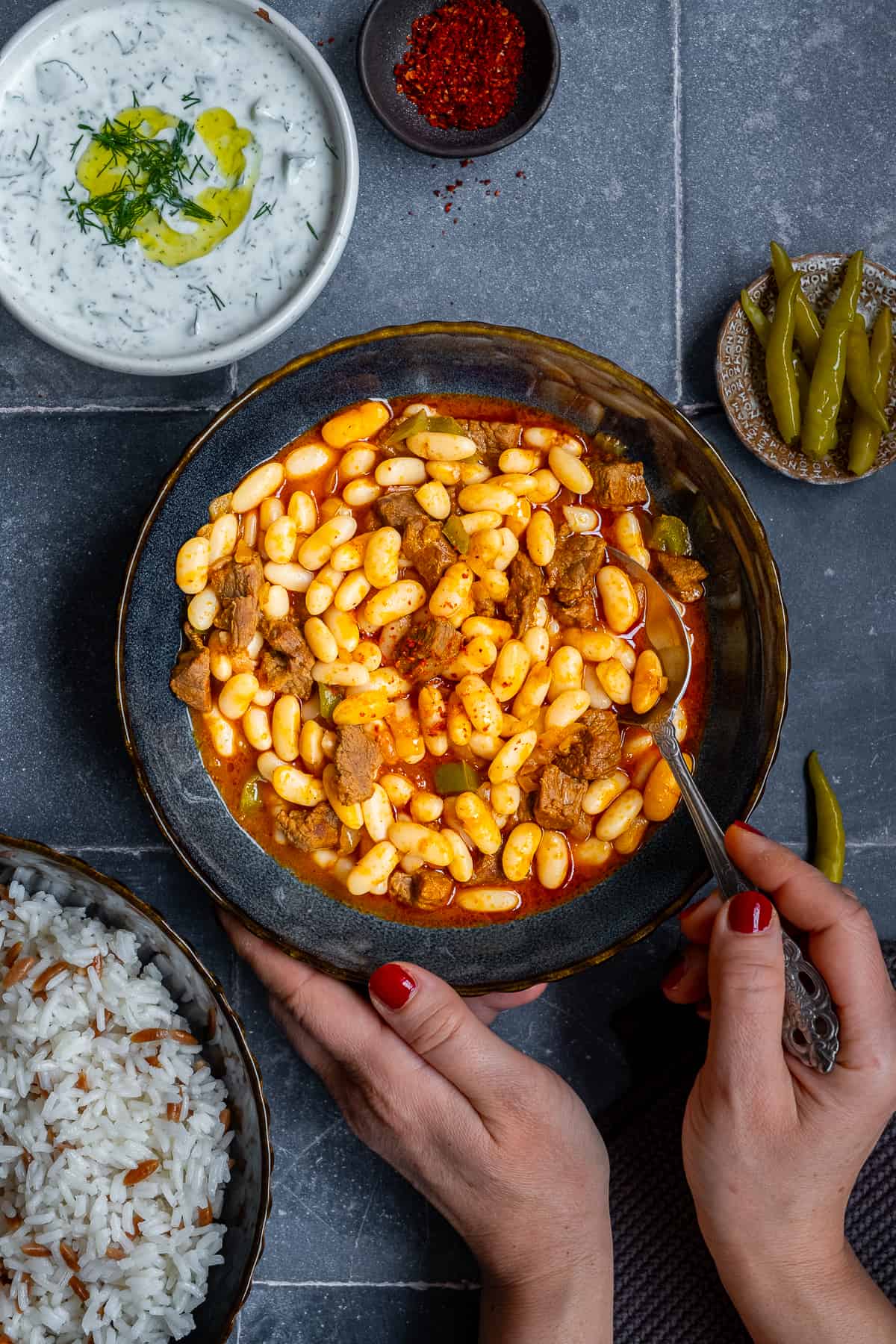
Variations
There are several kuru fasulye recipes across Turkey. Here are some popular variations:
With Lamb chops: Similar to diced meat, cook the lamb chops in a pot until tender. Add water when it gets too dry and let it cook until tender, for about 30 minutes.
With pastrami (Pastırmalı): Pastırma (seasoned, dried meat) should be added after cooking the onions, spices, and green peppers. Sauté the pastırma for a few minutes to release its flavors before adding the tomatoes, tomato paste, and water.
With Sujuk (Sucuk): Slice the sujuk (Turkish spicy sausage) into thin rounds and add them after cooking the onions, spices, and green peppers. Sauté the sujuk briefly to release its flavors and then continue with the recipe. Don't add any butter when using sujuk as it already has its own fat.
Vegetarian: For a vegetarian version, simply omit the meat and follow the rest of the recipe. If you want to add more vegetables, such as carrots or celery, chop them and add them after the onions have cooked and before the tomatoes, tomato paste, and water.
What to Serve with Kuru Fasulye
Want to enjoy kuru fasulye in the most traditional way? Find our favorite sides to pair with it.
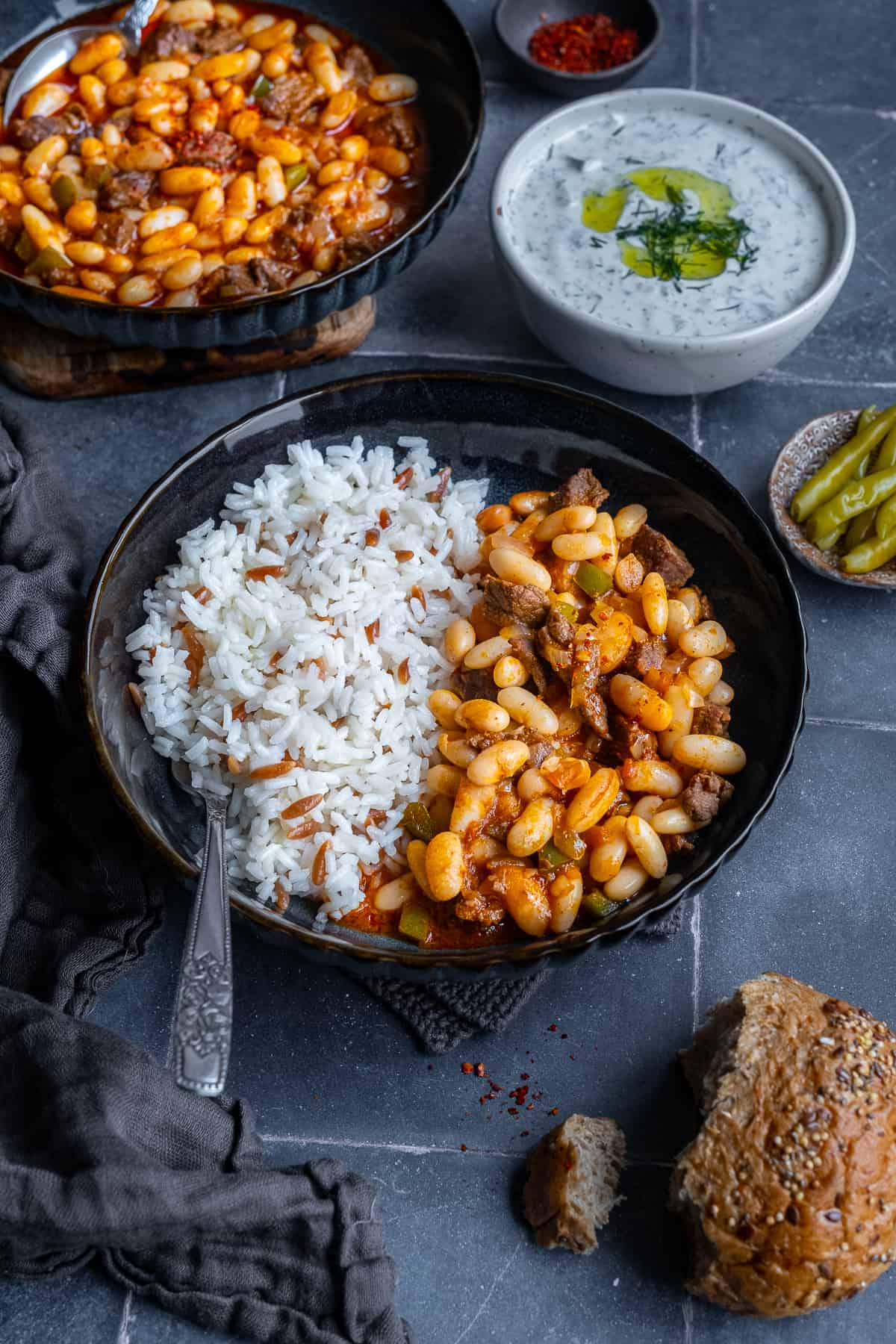
In the picture above, you see Turkish beans served with Turkish rice and cacık.
Pilav: It is often served with Turkish rice pilaf or bulgur pilaf. If you want even a more aromatic pilaf, try our rice with raisins. They all complement this hearty bean stew, creating a satisfying and complete meal.
Cacik: It is one of the most popular side dishes in Turkey. It is made with yogurt, garlic, cucumber and dried mint or fresh dill. Cacık perfectly balances the warmth of the bean stew.
Pickles: Tangy pickles give a crunchy and flavorful contrast to the soft beans and tender meat in the stew. Check out our quick cabbage pickles and quick beet pickles if you want to make your own pickles.
Bread: Serve it with breads like bazlama and Ramazan pidesi to scoop up the delicious stew or soak up any remaining sauce in your bowl.
Salad: Pair it with a simple, fresh Turkish shepherd salad or tangy red onion salad with sumac.
Garnish: Sprinkle fresh parsley or dill over the stew just before serving to add a touch of freshness and color to the dish.
Aaaand we always sprinkle some red pepper flakes on our etli kuru fasulya for extra flavor and heat.
Imagine all these on the table. If this dinner doesn’t make you feel in heaven, we don’t know what will!
Storing & Reheating
Storing in the fridge
- Allow the leftover Turkish beans to cool to room temperature.
- Transfer it to an airtight container or cover the pot with a tight-fitting lid or plastic wrap.
- Store it in the refrigerator for up to 3-4 days.
Freezing
- For longer storage, you can freeze kuru fasulye. Once cooled, transfer it to a freezer-safe container or heavy-duty freezer bag, leaving some space at the top for expansion.
- Label the container with the date and contents before sealing.
- Store it in the freezer for up to 3 months.
Reheating
- If you've stored the bean stew in the refrigerator, reheat it in a saucepan over low to medium heat, stirring occasionally until warmed through. You can add a little water or broth if needed to thin out the stew.
- If you've frozen it, allow it to thaw in the refrigerator overnight or use the defrost setting on your microwave. Once thawed, reheat it following the same method as above.
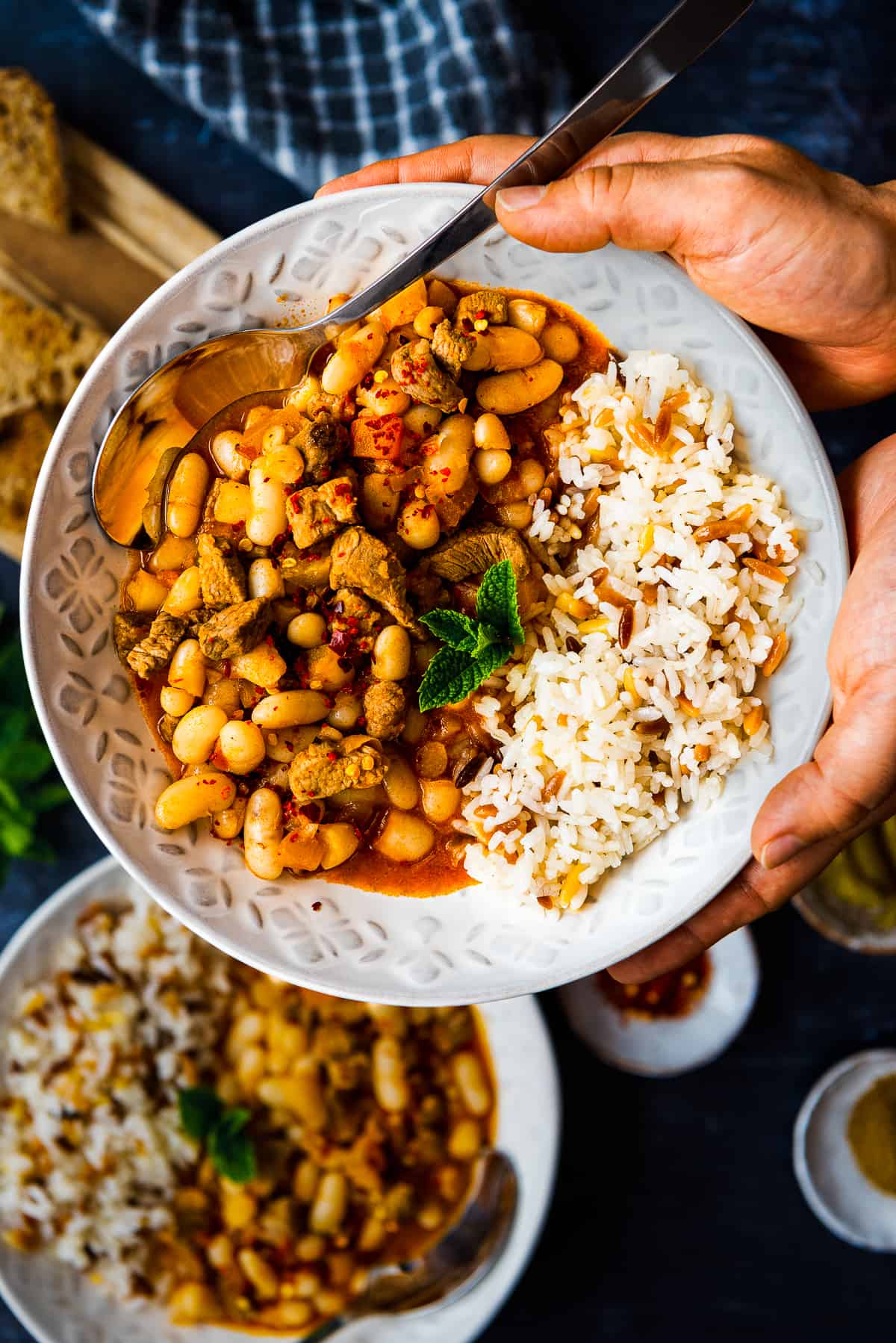
FAQs
In Turkey, Dermason or Ispir beans are traditionally used. However, if these are not available, Canellini or navy beans make good substitutes due to their similar texture and flavor absorption properties.
It's best to soak the beans overnight, or for at least 8-10 hours. This ensures they cook evenly and become perfectly tender.
The cooking time can vary, but typically it takes about 1 hour and 15 minutes in total including the cooking time of meat.
Other Bean Recipes
- Turkish Bean Salad Piyaz
- Black Bean and Lentil Soup
- Broad Beans Recipe
- Zeytinyagli Taze Fasulye (Turkish Green Beans)
- Dry Broad Beans
- Fava Beans Dip
- How To Cook Broad Beans
More Hearty Turkish Recipes
As always: If you make this recipe, let us know what you think by rating it and leaving a comment below. And post a pic on Instagram too—tag @give_recipe so we can see!
Sign up for the FREE GiveRecipe Newsletter to get the new recipes into your inbox! And stay in touch with us on Facebook, Pinterest, YouTube and Instagram for all the latest updates.
📖 Recipe
Kuru Fasulye Recipe (Turkish Beans)
Kuru fasulye is a comforting and flavorful Turkish bean stew made with white beans, tender meat, and aromatic spices. This Turkish dish can be enjoyed with various meats or as a vegetarian option. Traditionally served with Turkish rice or bulgur pilav, kuru fasulye makes for a satisfying and wholesome meal that can be easily prepared and customized to suit your taste preferences.
- Prep Time: 8 hours and 20 minutes
- Cook Time: 1 hour and 20 minutes
- Total Time: 0 hours
- Yield: 6 1x
- Category: Dinner
- Method: Cooking
- Cuisine: Turkish
Ingredients
- 2 cups (400 grams) dried white beans (cannelini beans or navy beans)
- 1 tablespoon olive oil
- 400 grams (14 ounces) diced beef
- 57 grams (2 ounces or 4 tablespoons) butter
- 2 small onions, diced
- 2 tablespoons tomato paste
- 1 teaspoon pepper paste (see the note 5 below)
- 1 tomato, ¼ cup diced
- ¼ cup diced green peppers
- ½ cup water
- 1 and ½ teaspoons salt
- 1 teaspoon cumin
- 1 teaspoon black pepper
- 1 teaspoon paprika
- 4 cups water
Instructions
Soaking the Beans
- Thoroughly rinse the white beans.
- Place the rinsed beans in a large pot or bowl.
- Cover the beans with a generous amount of water (we use 8 cups) and allow them to soak for a minimum of 8 hours or overnight. This process helps the beans cook faster.
Cooking the Beans
- Drain and set aside the soaked beans, discarding the water used for soaking.
- In a large pot, add the beans and cover them with 4 cups of room temperature water. Bring to a boil without a lid.
- Once boiling, lower the heat to medium-low. Partially cover the pot and simmer until the beans are tender, which should take about 35-40 minutes. Start checking at 30 minutes as cooking times can vary based on bean type.
- Skim off any foam from the surface once or twice during cooking.
Cooking the Meat
- In a large saucepan or Dutch oven, heat olive oil over medium heat.
- Add diced beef and cook on medium-high heat for about 5 minutes or until it releases its juices.
- Stir well, then lower the heat. Cover and simmer on medium-low for approximately 20 minutes, ensuring there's enough juice in the pan. If dry, add ¼ cup of water and continue to cook covered for an additional 20-25 minutes until tender. Regularly check and add water if needed.
- Note: If using lamb, cooking time is typically shorter, around 30 minutes.
Assembling the Stew
- When the meat is tender, add butter to the pot, stirring until melted.
- Add diced onion, cover, and cook on medium-low heat about 5 minutes or until soft, stirring occasionally.
- Mix in tomato paste and red pepper paste, cooking for 2-3 minutes with constant stirring.
- Introduce diced pepper and tomato, stir well, and cook covered for 3 minutes on medium-low heat.
- Add ½ cup of water to the pot, stirring thoroughly.
- Incorporate the cooked beans along with their cooking water and all spices, stirring well.
- Bring the mixture to a boil over medium-high heat, then reduce to medium-low and simmer for 10 minutes.
- Allow the stew to rest for 15 minutes before serving.
- Serve with Turkish rice or bulgur pilav and cacik.
Notes
- After soaking the beans, throw out the water. Cook them in fresh water. Otherwise, your stew won't taste good and the beans will cause gas.
- Don't skip removing the foams from the surface of the beans while cooking.
- If the meat gets dry when cooking, add a little water and keep cooking until tender.
- Keep in mind that lamb cooks faster than meat.
- Red pepper paste adds great flavor, but it might be hard to find. The popular Turkish brand "Öncü" is available internationally. Look in Middle Eastern stores or on Amazon. If unavailable, simply use the same amount of tomato paste instead.
- Storing: Cool stew, put in airtight containers, keep in the fridge for 3-4 days. To store in the freezer, cool the stew, divide into portions in freezer bags, and freeze up to 2-3 months.
- Reheating: Heat on stove or microwave until warm. To reheat from the freezer, thaw in the fridge or microwave, then reheat as above.
Nutrition
- Serving Size:
- Calories: 415
- Sugar: 3.7 g
- Sodium: 669.8 mg
- Fat: 12.8 g
- Carbohydrates: 45.5 g
- Protein: 31.4 g
- Cholesterol: 60.4 mg


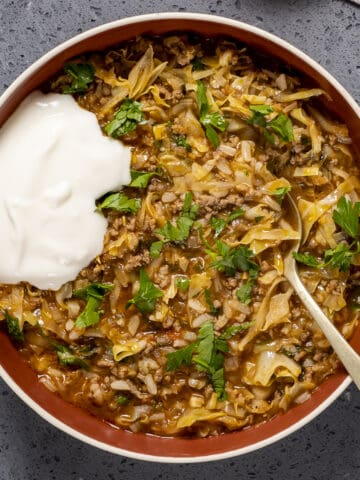
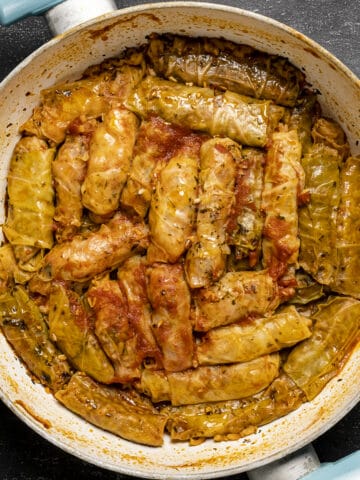

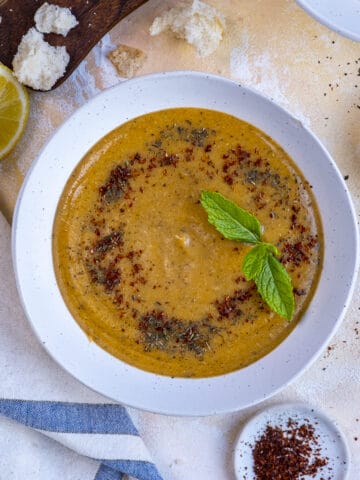

Jennie L. says
It has been cold and rainy this week, and so I was looking for a warming, hearty soup for lunch. Oh my. This was so good. I didn't have pepper paste, but I added one small jalapeno for a little heat. (Is pepper paste hot?) It was just right. I still wonder at how so few spices can create such a rich and flavorful broth.
Thank you again.
Zerrin & Yusuf says
Hi Jennie,
Thank you for such a lovely comment! We are so glad you liked this recipe, which is a very special one in Turkey.
We love kuru fasulye on rainy days too. Adding a jalapeno pepper is brilliant! Sometimes we add a small chili.
Well, red pepper paste has two versions, hot or sweet (meaning not hot). It just adds some more depth to the stew, but you can still have great results without it. Just like you did.
Thanks again for letting us know what you think.
Cheers!
Greg says
I finally found what i was looking for so many years. In 1996 I was in Istanbul an ate some kind of beans in a place which also served rotisserie chickens and lambs heads. I really didn't pay attention to the name of the dish but it was so delicious. Now I know what it was and making it tomorrow. Only one thing I am pretty sure that they used some of this rotisserie chicken drippings in theirs beans. Did you hear about restaurants doing this or it was only my imagination?
Zerrin & Yusuf says
Hi Greg,
We are glad you have found the recipe you enjoyed once in Istanbul. There are several restaurants (lokanta in Turkish) that have rotisserie chicken, lamb heads, bean stew (kurufasulye) and several other dishes on their menu. Bean stew is often served as a topping on rice or bulgur pilaf in these places. And in such restaurants, they are likely to use the drippings of chicken or roasted lamb in their bean stew. Every detail is like to have even more flavor.
Would love to hear what you think when you try our recipe. Please let us know!
Em says
I am American with a Turkish husband and he absolutely loved this. Said it was perfect and even ate it the next day. Definitely will be making this many, many times in the future!
Zerrin & Yusuf says
Soooo happy to hear this! Kuru fasulye (Dried bean stew) is a favorite of all Turkish people. And we are glad your husband (and hopefully you) loved this classic recipe.
Fidel says
Made these using a combination of various beans. So comforting and full of flabors!
Yusuf says
Hi Fidel,
Making it with a variety of beans is brilliant!
Sarah says
This is a delicious recipe! I recently found these beans at a lebanese market and wanted to try something a little more specific with them! This stew was a perfect fall meal. I substituted the red pepper paste for tomato, and it turned out delicious! I also added in some celery and garlic.
Yusuf says
Hi Sarah! Glad you liked our favorite bean stew. We make it often in fall and winter. Adding celery and garlic is brilliant! Thanks for the feedback!
Jeffrey Podsobinski says
Hi
would this be the recipe that almost every truck stop/ gas station serves in your countyr? from Urfa to Trabzon we ate this every day and loved it with ekmeck. ah the good old days.
thank you
Jef
Rich says
Beans, lamb, tomatoes and pepper? Wow, how have I never had this before? It sounds incredible!
Tangled Noodle says
I can't tell you how much we love the bean and meat combination. White beans and lamb is such a delicious combination and I will definitely make this.
The custom of 'breaking onion' is so interesting! If I'd seen it practiced without knowing the symbolism, I might have thought it odd but your explanation give it meaning. Imagine all the tools, gadgets and appliances that make our lives easier but that generations before us never had. Yet they still managed to eat well and live life! 😎
Natasha - 5 Star Foodie says
Beans and lamb sound so good and comforting in this dish! Delicious!
Leesie says
White beans and not just any meat, but LAMB! I will have to try this one sometime. It sounds like a very nourishing and tasty meal. Thank your dad for me ;-0
Mely says
This sure looks like something my husband would like. So, we must give a try. 🙂
Zerrin says
Gera- I'm sure it's very tasty with beef. And I love remembering such traditions.
Jenn- How nice it is to prepare something yourself rather than buying a prepared one. I hope you love it.
Lisa- You know I didn't want to be in between, so I made both versions. And guess what? They break onions together! 🙂
lisaiscooking says
I like the story of breaking an onion! Your beans look fantastic, and you're so nice to make two version for your husband and father.
jenn says
tried and true classics never fail to please. i used to eat something similar, but most of the ingredients came from a can. Now I can make it from scratch.
Gera @ SweetsFoods says
A comfort, nice and hearty dish Zerrin here I'd do it instead of lamb with beef both so delicious…traditions are traditions why not ?;)
Cheers!
Gera